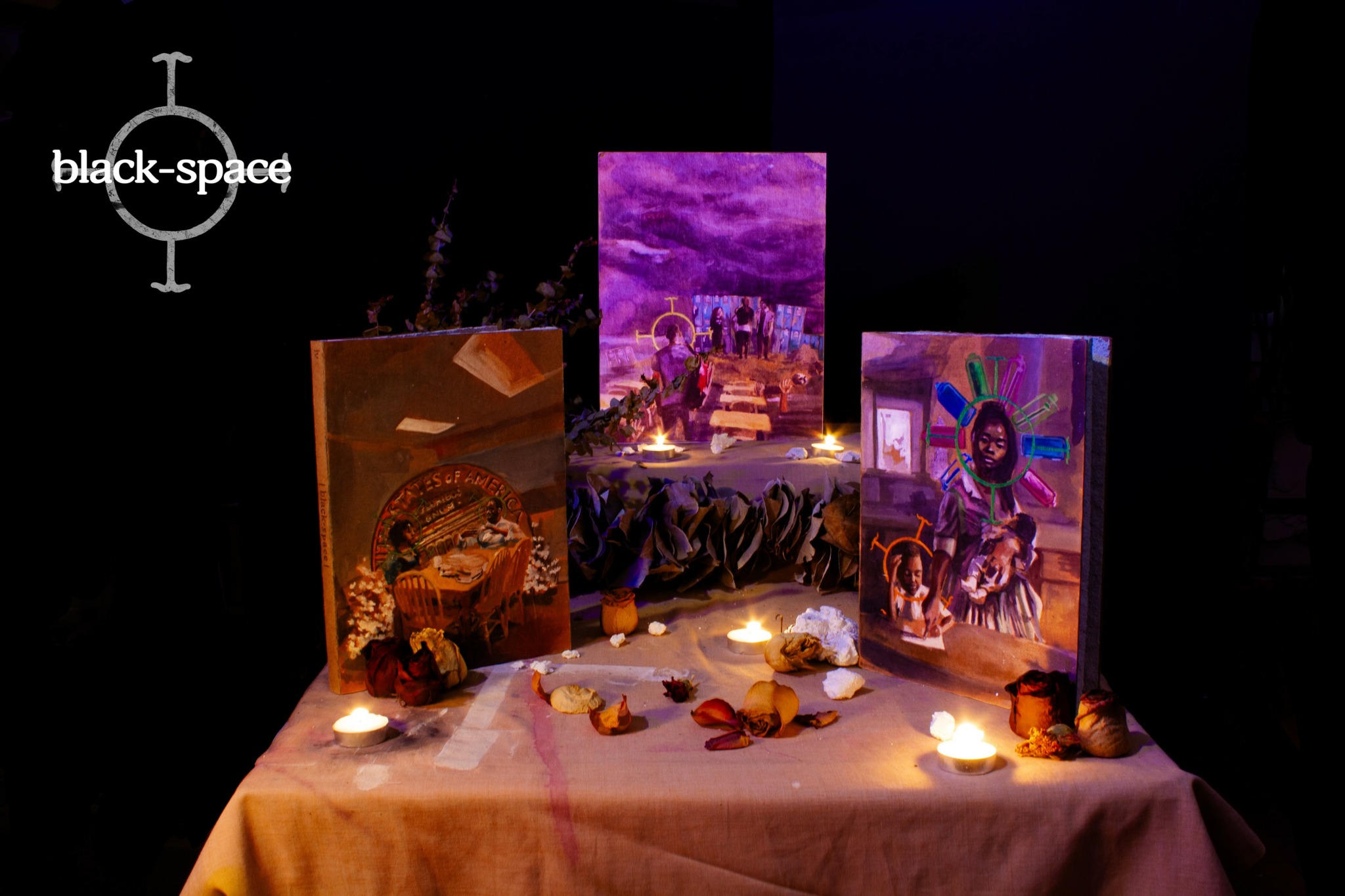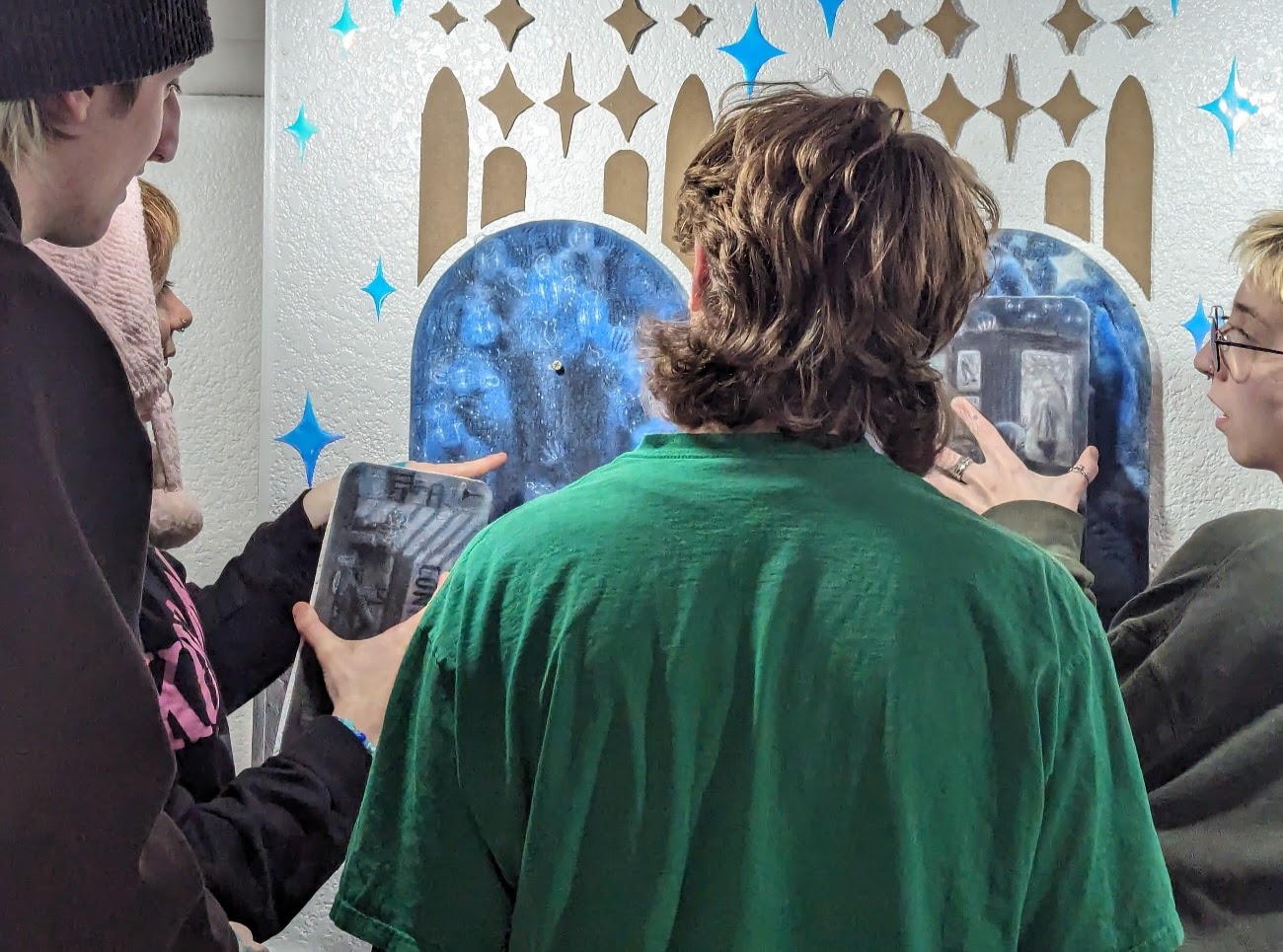We were lucky to catch up with Ian Izard recently and have shared our conversation below.
Alright, Ian thanks for taking the time to share your stories and insights with us today. What’s been the most meaningful project you’ve worked on?
The most meaningful project I’ve worked on is definitely my “tablets” series. The series is about my evolving relationship with technology and the roller-coaster of emotions that come with it: desire, dread, awe, and the feeling of magic living just behind the screen.
I’ve been developing this project since my last semester in college, and I’ve experience all sorts of ups and downs as I’ve continued to refine the series into something I’m truly proud of. As time goes on, I’ve noticed the echoes of this project in each smaller project I’ve worked on since then.
The simplest works were oil paint on drywall panels; but since then, they’ve expanded to include acrylic & watercolor, graphic design, bookmaking, integration with technology, interactivity, and immersive display building.
All of these pieces evolved from disparate parts of my practice and it’s been a wild journey as I’ve pulled all of these varied parts of my identity together to create something that can truly encapsulate everything I feel about technology and those mystical tablets that I’ve grown up alongside.


Awesome – so before we get into the rest of our questions, can you briefly introduce yourself to our readers.
I’ve been in the Arts for as long as I can remember.
In grade school, I was taking extra-curricular music classes, drawing and painting, participating in musicals, sound-engineering for my local church, and making stop-motion animations with my older brother.
As I transitioned into high-school, I really leaned into the theatrical arts; I spent most of my time after school in stage crew, learning everything I could about set-design, lighting, sound, painting. I was really privileged to be at a school that has a really hands-on approach to theater and the arts, and some of my fondest memories of that time include: learning how to make stained-glass, participating in high-school state theater festivals, taking trips abroad to shoot short films, interning for their summer theater camp, and displaying art in the Milwaukee Art Museum Quadracci Pavilion which led to the receipt of a gold-key award from the Scholastic Art and Writing Awards. It really lit a fire in me to be in the arts as much as I possibly could.
Once I got into college, I dove fully into the arts and I haven’t looked back since. I took screenwriting and play-writing classes, read every bit of art theory I could get my hands on, painted for hundreds of hours, and developed a lot of invaluable connections within the Milwaukee Art-scene.
In the 3-years since graduation, I’ve build my own website, designed posters for my brother in LA, worked with local galleries to put together interactive displays, developed a number of products that integrate NFC interaction into artwork, and worked with local zine-makers to publish my work.
Through all of those early experiences, I was constantly butting against problems of feasibility and budgetary limitations; I think all these developmental experiences are where I honed my problem-solving skills. We never truly gave up on an idea; we just found a way to adapt the scope of the project to meet any constraints we had. I’ve really taken this to heart, as I now have a good sense for how to effectively pivot in a project to keep things on-time and running smoothly. There’s never a day when a project doesn’t deviate from the set plan: technology always finds a way to misbehave, budgets are constantly responding to changes in the economy, and exhibitions usually develop in ways that make changing marketing materials a constant possibility; but through it all I’ve found ways to persevere and keep pushing forward.
I recently became an art instructor for Fever’s Neon Brush Experience here in Milwaukee, where I feel I can really help expand the layperson’s understanding of painting and self-expression. It’s amazing to see what people can do when they’ve got the encouragement and guidance to make whatever image comes to their mind.
I’ve also been working on a number of art books and zines that bridge the gap between fine-art and craft, and I’m eternally grateful to all the individuals who’ve helped me along the way. A lot of these artists have helped me refine my craft as well as providing me with exhibitions, tabling opportunities at art-fairs, and poetry-reading opportunities. I’m so proud of the books that I’ve made already, as well as the ones in development right now. One such opportunity that I’m really looking forward to is participating in a poetry marathon this upcoming winter. I’m also really excited to be connected to a local Mutual-Aid organization, GAG-ORDER, that seeks to platform and amplify marginalized voices in the community.

![]()
In your view, what can society to do to best support artists, creatives and a thriving creative ecosystem?
Some things I tell people are to “trust the process” and to “go outside and support the artists within your local community.” Most art practices don’t develop in a straight line; there’s a lot of twists and turns. A lot of detours seem pointless or frustrating from an outside perspective, but we are all products of our environments and experiences. Each of those experiences builds a little bit of our identities and shape who we can become in the future. When people only show up for things that are popular or viral, it makes a lot of artists become disheartened and think that they’ll only make art if they do what’s trending.
I often look at artists on Instagram or TikTok, who’ve developed these massive followings overnight from a single viral moment, and feel envy for their successes.
“If only I thought of that.”
“I could do that too, and better.”
“What is it about this that people find exciting or engaging?”
“How can I go viral like them?”
These thoughts constantly plague me, both awake and asleep
But the things we see on the Internet, and the stories we hear, are just a small sliver of their journey. We can never really see all of the invisible-hours they’ve spent honing their skills and craft; and a lot of the time, you’ll hear these creatives lamenting about those same successes.
They may talk about how it’s given them opportunities and visibility, but it really limited their growth. A lot of the things that we enjoy on the internet, we also expect to stay the same forever. We ask them to keep making the content that we like so that we can consume it easier or more frequently. Or we’ll ask them to keep showing us this art for free, even when it’s not economically feasible to do.
Internet stardom has become a Sword of Damocles, a double-edged sword that hangs over the heads of anyone who manages to curry its favor. In the process of appeasing the masses, a lot of creatives lose sight of the process, and how the process includes the continued development of their craft to higher and higher levels of refinement.
This is one of the reasons why I make my art the way that I want, on my own terms. I don’t make time-lapses of my process (although I do make a lot of stories that show snippets of the process). I don’t fight for interaction with my posts, or try to chase that next viral trend. I know that these things are somewhat necessary to success on the internet, but internet success isn’t necessarily the same thing as success within the Art Industry. Instead, I try to see where this work fits within my local community first.
Natural development of those things takes time, and everything good takes time until it’s ready to step into the light. Lust for results has a way of leading people down paths they may not have been ready for.
But with all that said, the people watching can still do their part to support the artists that they’re fans of. We can all stand to: show up more, spend money on the things we care about, offer words of praise or encouragement for the work we like, and to feel a sense of loyalty to the people producing the content that we enjoy. None of those things mean we have to universally accept work that’s unfinished or sub-par, but it does mean showing love to the people who’ve sacrificed countless hours to make the work we admire so much.
The Internet has convinced a lot of people that art can and should be free, but everything has a cost. If we’re not willing to pay that cost, then someone else has to do it, using whatever means they can.


What do you think is the goal or mission that drives your creative journey?
My mission has always been to communicate my perspectives of the world passionately and clearly.
I think the hardest thing to do is striking a balance between the two, because there’s a lot of work that has to be done to bridge the divide between what we as creatives believe and see, and what the audience will take away from that experience.
The inherent subjectivity of art means that everyone has a unique perspective that they’ll take with them into the creative experience; but that doesn’t necessarily mean that we should abandon critical analysis of the works that we interact with. Instead, it means that we have to understand the context and environment that the creator existed in, as well as the contexts that shaped our own interpretations.
A lot of my creative journey has been learning: learning how to communicate better, learning new skills and methods to get my work to audiences, learning how to make it financially viable and the compromises necessary to make it so, learning the contexts that shape the way my work is received, and learning about myself and the context I live in.
It’s my belief that the Internet and technology have become increasingly self-consuming, and one of my goals is to influence people to step back and stop putting so much of themselves into their online presence. Technology and media have truly become amazing, but we can’t exist completely online and we sacrifice a lot in the pursuit of such a reality.
I’ve spent so much time online, but my most fulfilling experiences and professional successes have come from endeavors to take those online connections and turn them into tangible experiences with the people who are close to me. That’s really the heart of the series I’ve been developing.
Contact Info:
- Website: https://ian-michael-izard.com
- Instagram: @ian.michael.izard




